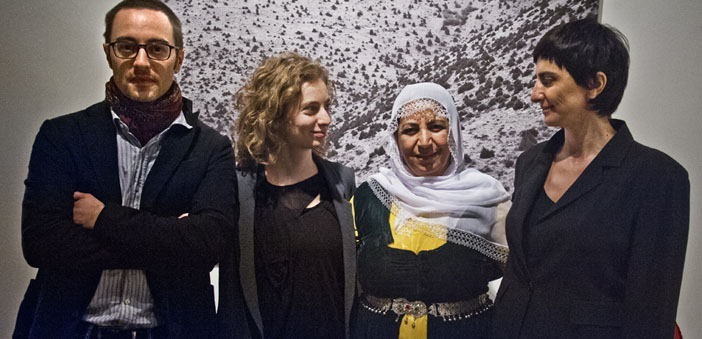‘Gülizar’ın hikâyesi kadınları yakınlaştırıyor’


Fotoğraflarda, üzeri kısmen çimentoyla kaplanarak saklanmaya çalışılan Ermeni mimarisine ait motifler ve duvarlara işlenen Ermenice harfler ile kilise yıkıntılarına dair görüntüler öne çıkıyor. Açılıştan önce kısaca konuştuğum Barsaghian ve Kristensen’a ilk olarak “Nedir bu hayalet meselesi?” diye soruyorum: “Normal şartlarda, öldüğümüzde bir merasim eşliğinde gömülürüz ve bir mezar taşımız olur. Ruhumuz böylece huzura kavuşur. Huzura kavuşamadığımızda ise hayaletlere dönüşürüz, ruhumuz yeryüzünde kalır. Öldürülen Ermeniler hâlâ bu topraklarda hayalet olarak yaşıyor ve bu toplumun yakasını bırakmıyor” diyor Kristensen. “Bu hayaletlerin özgür kalması için ne yapılmalı sizce?” diye sorduğumda Barsaghian sözü alarak “adalet geldiğinde bu ruhlar özgür kalacak” derken, Kristensen araya giriyor “Adalet gerekli, fakat kendi başına yeterli olmayabilir de...”
Ağıtta saklı tarih
Barsaghian’ın Gülizar’ın hikâyesiyle tanışması çocukluk yıllarına dayanıyor. Büyükannesinden Ermenice olarak Gülizar’ın ağıtını dinleyerek büyüyen sanatçı, 2005 yılında soykırımdan kurtulanların torunlarının kafile halinde Anadolu’ya yaptıkları gezilerden birine katılmış ve büyükannesinin Kars’taki köyünde, Gülizar’ın ağıtını bu kez oradaki köylülerden duymuş: “Neredeyse köydeki herkesin ilk anlattığı şey Gülizar’ın hikâyesi oldu. Ve bu hikâye anlatılırken Gülizar’ın ağıtından doğrudan alıntılar yapıldığını fark ettim.”
Güle’nin devam eden hikâyesi
Bu ağıtın kadınları yakınlaştırdığını ve onlar için bir direniş alanı yarattığını söyleyen Barsaghian, bu ağıt vesilesiyle dengbej Gazin’le tanışmış. Açılışta sahnelenen ‘Güle Çok Güzel’ isimli performansta canlı olarak Gülizar’ın ağıtını okuyan dengbej Gazin’in hayatında Gülizar’ın çok önemli bir yeri var: “ Ben küçükken nenem hep Gülizar’ın şarkısını okurdu. Ben de nenemin adını uzunca bir süre Güle sandım. Bu şarkıyı bir adama aşık olmuş da yazmış diye bildim. ‘Aşık mısın nene, neden bu şarkıyı okuyorsun’ diye sorunca anlattı nenem Güle’nin hikâyesini. Çok ağırıma gitti ona yapılanlar. O kadar etkilenmiştim ki bundan, öğrendiğim ilk dengbej şarkısı da Güle’nin ağıtı oldu. Hatta kızımın ismi de Güle’dir.”
Gazin’in nenesi Gülizar’ın hikâyesinin mutlu sonunu yanlış bildiğinden, Gazin Gülizar’ın kurtulduğunu bilmez, kahrından öldü sanırmış. Bu yüzden de Gülizar’ın torunu Meliné Ter Minassian’ı karşısında görünce şok olmuş. Gazin, erkek dengbejlerin Güle’nin ağıtını okurken “yalan yanlış” şeyler söylediğini anlatıyor son olarak: “Erkek dengbejler, Güle’nin Musa’ya kendi isteğiyle gittiğini söylüyor şarkıyı okurken. Hikâyenin doğrusunu kadın dengbejlerden dinleyin.”
Anna Barsaghian, Meliné Ter Minasssian ve Gazin’in beraber sahneledikleri performansın videosunun da gösterildiği ‘Spectograhpy: Hayaletlerin İzinde’ sergisini 12 Nisan’a kadar Depo’da ziyaret edebilirsiniz.
‘Gülizar’ı çok sevilmiş bir kadın sanırdım’
Açılışta, Armenuhi Kevonyan’ın torunu Meliné Ter Minassian; Anna Barseghian ve dengbej Gazin’le birlikte, ‘Güle Çok Güzel’ adlı bir performans sahneledi. Bu performansın sadece Gülizar’la veya Armenuhi Kevonyan’la olan kişisel bağını değil, onlarla ilgili olan toplumsal hafızayı da temsil ettiğini söyleyen Ter Minassian’a, Gülizar’ın Anadolu’da destanlaşan hikâyesinin ailedeki yerini soruyorum: “Bizim ailenin sadece bir tarafı Ermeni. Çocukken ailenin Ermeni olan tarafına daha yakındım, bu yüzden de benim hikâyemin, Gülizar’ın kızı olan büyükannem Armenuhi’yle büyük bir bağı vardır. Onunla çok güçlü bir ilişkimiz vardı. Armenuhi çok mutlu bir kadındı, capcanlı, dans etmeyi seven, şarkılar söyleyen, sürekli şakalar yapan bir kadın… Onun dışında ailede herkes siyasetle uğraşıyordu ve bu nedenle de çocukken bana Ermenilikle ilgili olan her şey çok ağır veya ciddi gelirdi. Tabii o zamanlar bilmezdim Ermenilerin başına gelenleri, çocukken anlatılmaz bunlar size. Olanları öğrendikten sonra bile, Armenuhi hep soykırım hikâyelerinden uzak, mutlulukla dans eden bir kadın izlenimini vermiştir bana. Armenuhi, annesi Gülizar’dan söz ederken de aynı izlenimi yaratırdı. ‘Gülizar’ın Kara Düğünü’nü okuyana kadar, Gülizar’ın sadece çok sevilmiş bir kadın olduğunu sanıyordum; kaçırılma, şiddet, tecavüz hikâyelerinden haberim bile yoktu. Kitabı 14 yaşıma geldiğimde, bir gecede okudum. Şok oldum.


